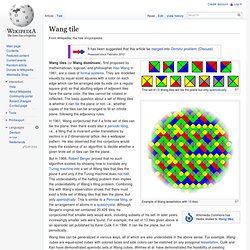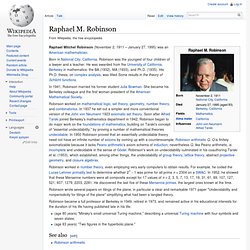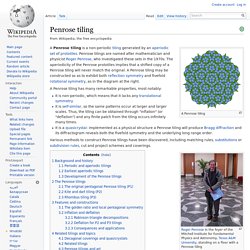

Wang tile. This set of 13 Wang tiles will tile the plane but only aperiodically.

Example of Wang tessellation with 13 tiles. In 1961, Wang conjectured that if a finite set of tiles can tile the plane, then there exists also a periodic tiling, i.e., a tiling that is invariant under translations by vectors in a 2-dimensional lattice, like a wallpaper pattern. He also observed that this conjecture would imply the existence of an algorithm to decide whether a given finite set of tiles can tile the plane. Wang tiles can be generalized in various ways, all of which are also undecidable in the above sense. Raphael M. Robinson. Raphael Mitchel Robinson (November 2, 1911 – January 27, 1995) was an American mathematician.

Born in National City, California, Robinson was the youngest of four children of a lawyer and a teacher. He was awarded from the University of California, Berkeley in mathematics: the BA (1932), MA (1933), and Ph.D. (1935). His Ph.D. thesis, on complex analysis, was titled Some results in the theory of Schlicht functions. In 1941, Robinson married his former student Julia Bowman. Penrose tiling. A Penrose tiling is a non-periodic tiling generated by an aperiodic set of prototiles.

Penrose tilings are named after mathematician and physicist Roger Penrose, who investigated these sets in the 1970s. The aperiodicity of the Penrose prototiles implies that a shifted copy of a Penrose tiling will never match the original. A Penrose tiling may be constructed so as to exhibit both reflection symmetry and fivefold rotational symmetry, as in the diagram at the right. A Penrose tiling has many remarkable properties, most notably: